Key takeaways:
- Vulnerability fosters a supportive community in workshops, enhancing authentic dialogue and creativity.
- Strategies like personal storytelling, small group discussions, and active listening create a safe and open environment for sharing.
- Establishing ground rules around confidentiality increases participants’ willingness to express their concerns and ideas.
- Measuring the impact of vulnerability shows increased participant engagement and long-term connections among attendees.
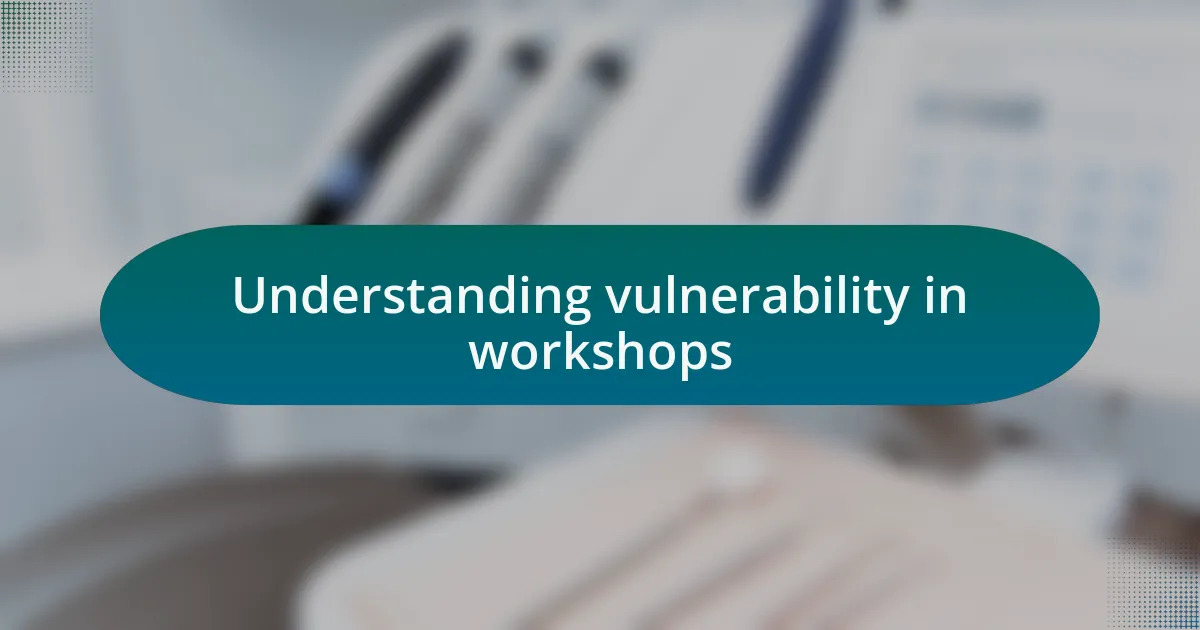
Understanding vulnerability in workshops
When I think about vulnerability in workshops, I often recall a session where a participant shared a deeply personal failure. It was a pivotal moment that shifted the atmosphere in the room; suddenly, everyone felt less like colleagues and more like a supportive community. This openness allowed for deeper discussions, fostering connections that wouldn’t have happened without that initial act of courage.
Vulnerability isn’t just about sharing personal stories; it’s about creating a safe space where people feel empowered to express their thoughts and feelings. Have you ever noticed how freeing it can be to voice a concern or idea that feels risky? I’ve found that when participants realize they are not alone in their struggles, it opens up a channel of authentic dialogue, where creativity and collaboration flourish.
In my experience, the beauty of vulnerability lies in its ability to bind people together. When workshop attendees see that even those in senior positions can be uncertain or flawed, it humanizes the experience. It raises an important question: isn’t embracing our imperfections what ultimately drives innovation? By encouraging vulnerability, we not only enhance individual growth but also cultivate a culture of trust and shared learning within our teams.
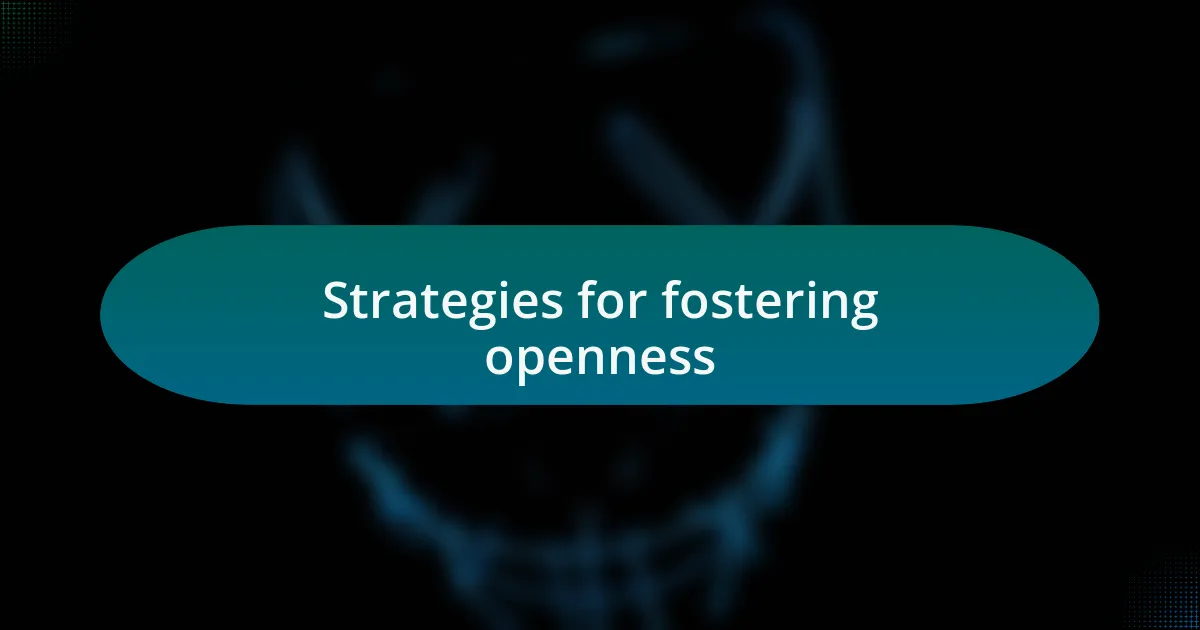
Strategies for fostering openness
Creating an environment of openness starts with setting the tone early on. In one workshop I led, I opened with a personal story about a project that didn’t go as planned. This vulnerability not only eased the tension in the room but also gave participants the encouragement they needed to share their own experiences, proving that transparency can break down barriers that often exist in professional settings.
Another powerful strategy is to incorporate small group discussions. I’ve seen how breaking into smaller circles can create a sense of intimacy that encourages quieter participants to voice their thoughts. Imagine sitting with a few colleagues, discussing challenges you all face – suddenly, the atmosphere feels lighter, and insights flow more freely. It’s as if those smaller gatherings act as safe havens where vulnerability is not just accepted but welcomed.
Finally, I believe in the importance of active listening during workshops. When I actively respond to participants’ shares with empathy and validation, I notice an immediate shift. It’s fascinating how a simple nod or a thoughtful follow-up question can invite deeper conversations. Have you ever noticed how refreshing it feels when someone truly hears you? This practice cultivates a culture where openness is not just encouraged but celebrated, allowing everyone to feel seen and valued.
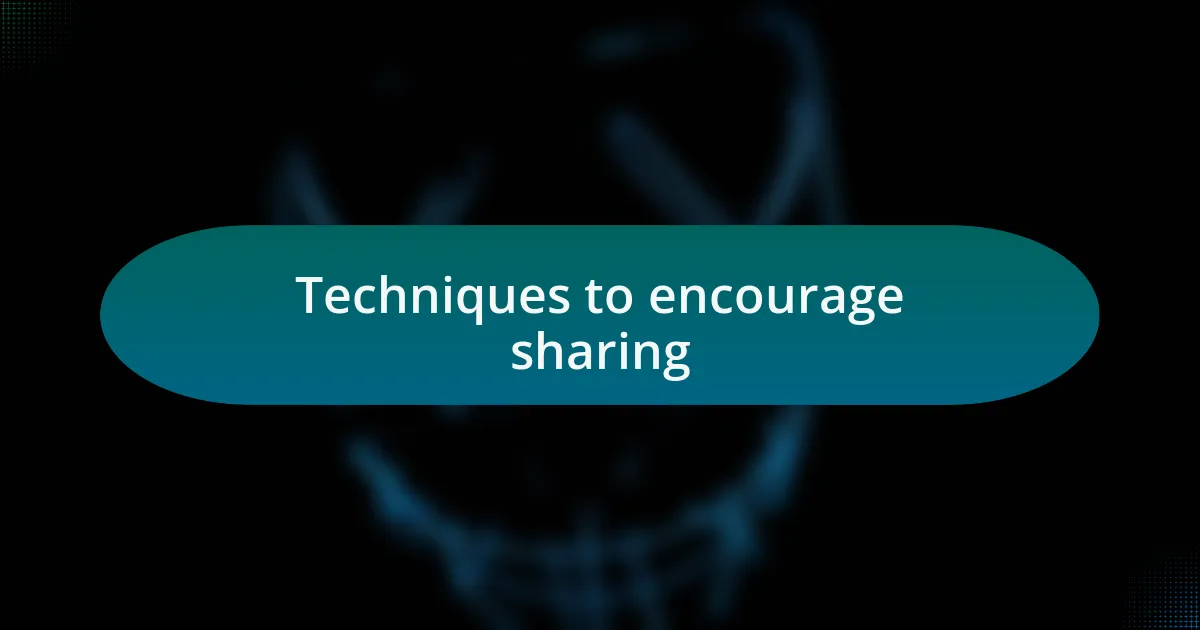
Techniques to encourage sharing
One technique that I’ve found particularly effective is using storytelling prompts. During one workshop, I asked participants to share a defining moment in their careers, and it was incredible to witness how their eyes lit up as they recalled those pivotal experiences. Why is storytelling so powerful? It allows individuals to connect on a deeper level, transcending typical workplace interactions and creating a shared human experience that encourages others to open up in return.
In addition, I always make it a point to establish ground rules around confidentiality. When I first introduced this concept at a tech event, I noticed an immediate shift in the group’s energy. By assuring participants that what’s shared in the room stays in the room, it fosters a sense of security that’s essential for vulnerability. Have you ever felt a weight lift when someone assures you that your thoughts are safe? This assurance empowers attendees to voice their genuine concerns and ideas, enriching the overall dialogue.
Moreover, incorporating icebreaker activities that require participants to share a fun fact or a personal goal can lighten the mood and break down initial barriers. I remember introducing a quirky question about hidden talents, which led to unexpected laughter and unexpected connections. This light-heartedness not only paves the way for deeper sharing but also reinforces the notion that vulnerability can coexist with enjoyment, making the entire experience more rewarding for everyone involved.
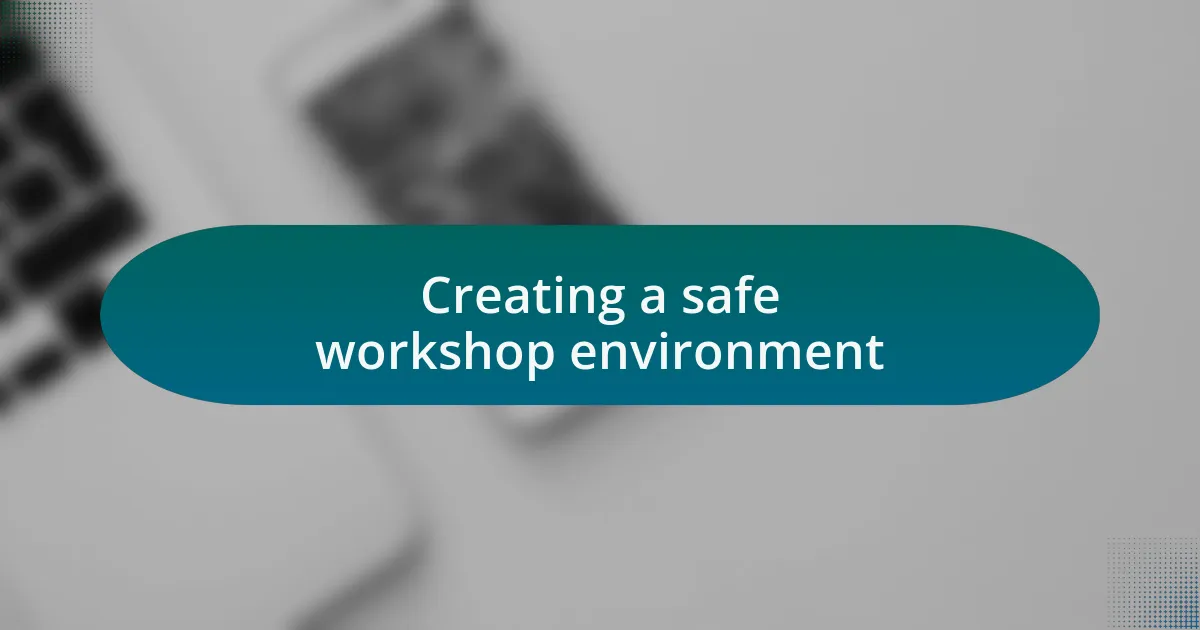
Creating a safe workshop environment
Creating a safe workshop environment hinges on fostering trust and openness from the very start. In one session, I encouraged participants to voice any fears or apprehensions they had about the workshop itself. The collective sigh of relief was palpable when they realized that everyone shared similar anxieties; I often find that naming our fears normalizes them and creates a bond that reinforces a safe atmosphere.
Physical space also plays a crucial role in making individuals feel secure. I prefer arranging seating in a circle rather than in rows, which can feel hierarchical. On one occasion, I noticed that when participants could see each other’s faces, it made them more at ease. Have you ever felt the power of being in a circle? It simply changes the dynamics, inviting more open and engaged participation.
Lastly, I often emphasize the importance of active listening among participants. There was a workshop where I paired attendees in twos and asked them to share a piece of personal insight while the other listened without interruption. The positive feedback I received afterward was telling; many remarked on how cherished it felt to be heard authentically. Listening isn’t just a skill; it’s a gift that enriches the space and cultivates a genuine environment for vulnerability.
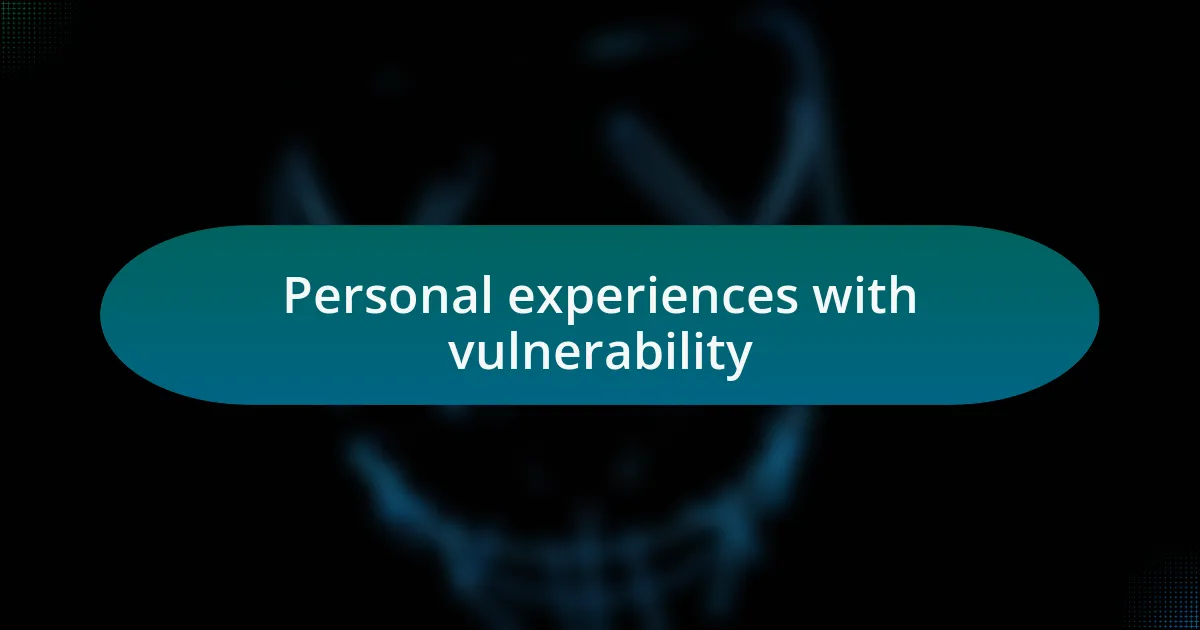
Personal experiences with vulnerability
Opening up about vulnerability in workshops has been a journey for me. I vividly remember a moment when I shared my own fears about leading a session. It took a lot for me to admit that I sometimes doubt my abilities, but when I did, I saw a shift in the room. Participants began to relate their experiences, and it struck me how that shared honesty created a deeper connection among everyone.
One time, I facilitated a workshop where I encouraged participants to write down their vulnerabilities on sticky notes and post them on the wall. The experience was both humbling and enlightening. I was struck by the courage displayed in those notes; some wrote about their fear of failure, while others expressed insecurities about not fitting in. Reading them felt like peeking into a hidden world, and it reinforced the power of vulnerability to bring people together.
There have been instances where I’ve felt overwhelmed by the weight of vulnerability, especially when leading discussions on emotionally charged topics. I found that sharing my experiences, like my struggle with work-life balance, allowed others to open up in ways they hadn’t before. Might vulnerability be a bridge to connection? From my perspective, it’s clear that when we dare to be authentic, we empower others to do the same.
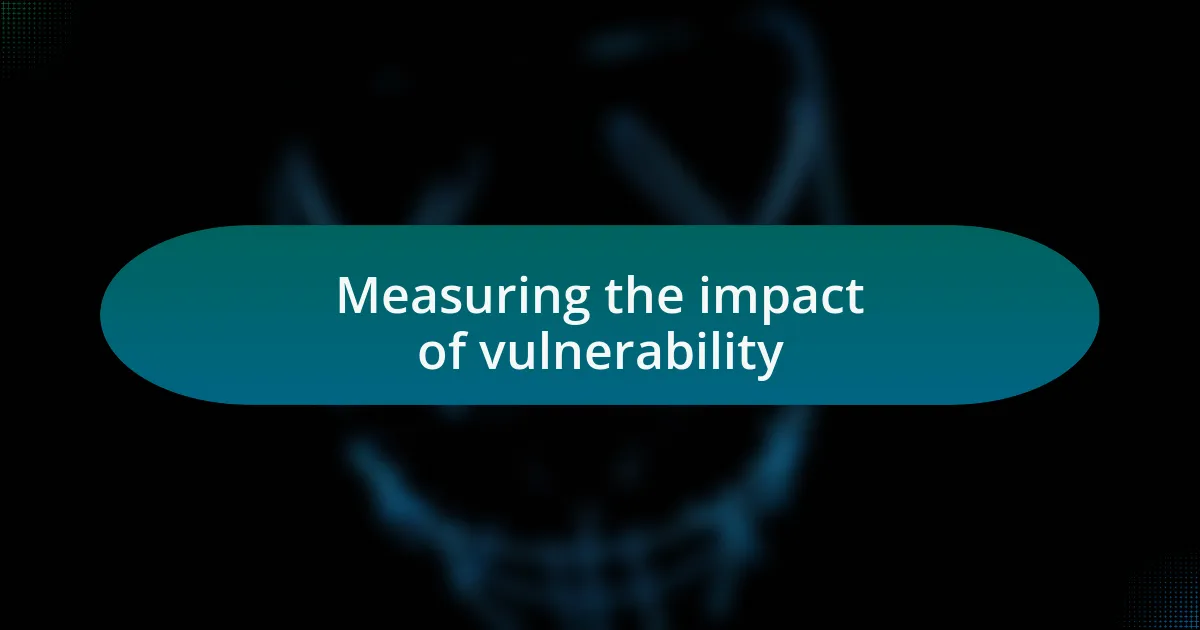
Measuring the impact of vulnerability
Measuring the impact of vulnerability can be surprisingly insightful. For instance, after incorporating vulnerability exercises in my workshops, I noticed an increase in participation. One day, a participant shared how opening up about their anxiety during a group activity changed the dynamics, creating an atmosphere where others felt safe to contribute their thoughts. This shift became a frequent theme; the more vulnerability was embraced, the more collaboration flourished.
Another way to gauge the effects is through feedback surveys post-workshop. I often ask participants how sharing their experiences affected their comfort level and engagement. I recall a particularly responsive group where, after a vulnerability exercise, 90% reported feeling more connected to their colleagues. That revelation not only showcased the immediate benefits of vulnerability but also highlighted how these moments can transform the entire work culture.
I’ve also observed how vulnerability influences long-term relationships among participants. A few months after a workshop, several attendees reached out to form a support group centered around shared vulnerabilities. This not only reinforced my belief in the power of openness but also provided tangible proof of its lasting impact. So, can vulnerability truly foster a supportive community? My experiences suggest it certainly can.